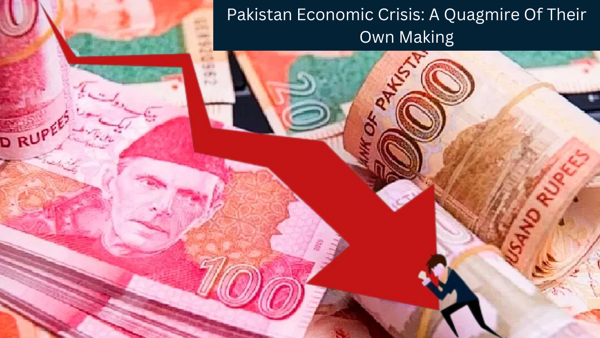
Economy
Pakistan Economic Crisis: A Quagmire Of Their Own Making; The Currency Falls Precipitously, And Inflation Reaches An All-time High
"Oil may run out, liquidity may dry up, but the next chapter of Life will continue to be written as long as ink flows freely." — This is exactly what is happening to Pakistan's economic foundation. Pakistan's economy is dangerously teetering on the precipice of two extremes: the door to hell and a harsh climate.
Pakistan is spiraling deeper into crisis as a result of a dollar shortage, accelerating inflation, a growing terrorist insurgency, and a worsening political crisis. Pakistan has reached an agreement with the IMF for $6.5 billion to address an economic crisis that existed in 2019 prior to the Covid-19 pandemic and European conflict.
Under that agreement, Pakistan was supposed to receive only $1.1 billion this year, but the country has failed to secure that loan even in today's economic conditions, and the IMF imposed some unbearable conditions on a country that is already struggling economically before releasing the loan amount.
The reason behind these conditions is that Pakistan has already approached IMF 22 times and every time the nation, Pakistan, has failed to return the loan money. This time, the IMF has imposed rules before lending money to the Pakistani government because every Pakistani politicians have severe cases of corruption, and lending money always ends up in the hands of powerful politicians, army generals, and bureaucrats.
As a result of the IMF conditions, the Pakistani government is required to eliminate all artificial currency and market manipulation. This has resulted in the Pakistani currency's free fall and pushed inflation to its zenith.
Annual inflation in Pakistan, as measured by the Consumer Price Index (CPI), reached a new high of 31.55 percent in February, up from 27.6 percent the previous month, due to massive increases in food and transportation prices. According to Arif Habib Corporation, this is the highest-ever CPI increase since July 1965.
Inflation in urban and rural areas increased by 28.82% and 35.56%, respectively, according to the Pakistan Bureau of Statistics (PBS). On a monthly basis, inflation is 4.32%. Because of the fragile economic and political conditions, inflation will remain high for the rest of the year and in the coming years.
According to the Ministry of Pakistan, CPI-based inflation will be 28-30% year-on-year in the coming months.
Not only is inflation harming Pakistan's economy, but so is the free fall of the Pakistani rupee. Because Pakistan is an import-heavy country, the country's forex reserves have reached an all-time low.
The Pakistani rupee fell 6.6% yesterday to an all-time low of Rs285.09 per dollar. The open market value of Pakistani currency is around Rs. 300, which is intolerable. This is the country's second-largest drop, as it struggles to restart a stalled IMF loan program. The open market value of Pakistani currency is around Rs. 300, which is intolerable.
Foreign exchange reserves held by the State Bank of Pakistan have also shrunk in recent months to levels barely sufficient to cover three weeks' worth of imports, despite a $556 million increase to $3.81 billion in the previous week.
As a result, Pakistan asked its strategic allies for a loan, and Pakistan has received a $700 million deposit from the China Development Bank at an undisclosed interest rate, which obviously will help the country's foreign exchange reserves. The deposit comes at a time when Pakistan is struggling with external debt and only has enough dollars to cover three weeks of imports.
Pakistan's total external debt increased from $37.2 billion in December 2022 to $126.3 billion in 2022. This external debt is killing Pakistan's economy, and any additional loans will not help the country's economy; instead, they will push it deeper into the shadow of debt.
This condition is Pakistan's own making. Pakistan accepted loans and grants from its allies in order to combat terrorism in the country and in neighboring Afghanistan. However, the flow of money has abruptly ceased, and the country is now struggling to stay afloat because Pakistan never developed as a nation-state and lacks a manufacturing base. And the corruption at all levels within the country has paralyzed the nation to its zenith.

0 Comments